Sustainability Development through a Nearly Zero Energy Building Implementation Case: An Office Building in South Jakarta
Abstract
:1. Introduction
2. Theoretical Review
- Reducing energy utilization dissipation from the start through passive design, for instance, sealing gaps between doors and floors, using double entrance doors, etc.
- Increasing energy savings through active design, for instance, replacing old air conditioning (AC) with smart AC, using LEDs for lighting, etc.
- Generating electricity through implementing renewable energy sources, such as photo voltaic (PV), wind, microhydro, etc.
3. Research Methodology
4. Result and Analysis
4.1. Study Case
4.2. Detailed Calculation and Sensitivity Analysis
4.2.1. Cooling Tower and CWP
4.2.2. AC Automation System BAS
4.2.3. LED Dim Lighting
4.2.4. Solar Panel Installation
4.2.5. Combination Scenario
5. Conclusions
Author Contributions
Funding
Institutional Review Board Statement
Informed Consent Statement
Data Availability Statement
Conflicts of Interest
References
- UNEP. United Nations Environment Programme. Towards Zero-Emission Efficient and Resilient Buildings, Global Status Report 2016, Prepared by Global Alliance for Buildings and Construction (GABC). 2016. Available online: https://goo.gl/oWUi3Y (accessed on 4 March 2024).
- Statista. Aggregated Ffloor Area of Buildings Worldwide from 2010 to 2022 with a Forecast for 2030. 2024. Available online: https://www.statista.com/statistics/1414826/global-buildings-floor-area/ (accessed on 4 March 2024).
- GABC. Global Alliance for Buildings and Construction, International Energy Agency and the United Nations Environment Program 2019: 2019 Global Status Report for Buildings and Construction: Towards a Zero-Emission, Efficient and Resilient Buildings and Construction Sector. 2019. Available online: https://globalabc.org/sites/default/files/2020-03/GSR2019.pdf (accessed on 4 March 2024).
- Goldstein, B.; Gounaridis, D.; Newell, J.P. The carbon footprint of household energy use in the United States. Proc. Natl. Acad. Sci. USA 2020, 117, 19122–19130. [Google Scholar] [CrossRef] [PubMed]
- IEA. Greenhouse Gas Emissions from Energy. International Energy Agency, Paris. 2021. Available online: https://www.iea.org/data-and-statistics/data-product/greenhouse-gas-emissions-from-energy (accessed on 12 November 2023).
- Ritchie, H.; Rosado, P. Energy Mix, OurWorldInData.org. 2024. Available online: https://ourworldindata.org/energy-mix (accessed on 4 March 2024).
- Ó’Riain, M.; Harrison, J. Cost-optimal passive versus active NZEB. How cost-optimal calculations for retrofit may change NZEB best practice in Ireland. Archit. Sci. Rev. 2016, 59, 358–369. [Google Scholar] [CrossRef]
- Sofia, E. Implikasi Paris Agreement melalui Program REDD+ berbasis blue carbon di Indonesia. J. Magister Huk. Udayana 2018, 8, 176. [Google Scholar] [CrossRef]
- Baden, S.; Fairey, P.; Waide, P.; Laustsen, J. Hurdling Financial Barriers to Low Energy Buildings: Experiences from the USA and Europe on Financial Incentives and Monetizing Building Energy Savings in Private Investment Decisions. 2006 ACEEE Summer Study on Energy Efficiency in Buildings. Washington, DC, USA. 2016. Available online: http://publications.energyresearch.ucf.edu/wp-content/uploads/2018/06/FSEC-PF-396-06.pdf (accessed on 4 March 2024).
- Harvey, L.D.D. Recent advances in sustainable buildings: Review of the energy and cost performance of the state-of-the-art best practices from around the world. Annu. Rev. Environ. Resour. 2013, 38, 281–309. [Google Scholar] [CrossRef]
- Bisegna, F.; Evangelisti, L.; Gori, P.; Guattari, C.; Mattoni, B. From efficient to sustainable and zero energy consumtion building. In Handbook of Energy Efficiency in Buildings: A Life Cycle Approach; Asdrubali, F., Desideri, U., Eds.; Butterworth-Heinemann: Amsterdam, The Netherlands, 2018. [Google Scholar]
- Waldek, S. Architecture: Is This Eco-Friendly “Smart Office” the Way of the Future? Architectural Digest. 2020. Available online: https://www.architecturaldigest.com/story/eco-friendly-smart-office-future (accessed on 12 November 2023).
- Gonzáles-Torres, M.; Pérez-Lombard, L.; Coronel, J.F.; Maestre, I.R.; Yan, D. A review on buildings energy information: Trends, end-uses, fuels and drivers. Energy Rep. 2022, 8, 626–637. [Google Scholar] [CrossRef]
- Peraturan Menteri Energi dan Sumber Daya Alam. Permen ESDM Nomor 13 Tahun 2012. 2012. Available online: https://peraturan.bpk.go.id/Details/142561/permen-esdm-no-13-tahun-2012 (accessed on 12 November 2023).
- DGE-MEMR. Direktorat Jenderal Ketenagalistrikan Kementrian Energy dan Sumber Daya Mineral Faktor Emisi GRK Sistem Ketenagalistrikan Tahun 2019. 2019. Available online: https://gatrik.esdm.go.id/assets/uploads/download_index/files/96d7c-nilai-fe-grk-sistem-ketenagalistrikan-tahun-2019.pdf (accessed on 12 November 2023).
- ACE. ASEAN Centre for Energy, ASEAN CO2 Emissions from Coal-Fired Power Plants: A Baseline Study. 2021. Available online: https://accept.aseanenergy.org/asean-co2-emissions-from-coal-fired-power-plants-a-baseline-study/ (accessed on 3 May 2024).
- Jones, T.W.; Smith, J.D. Historical perspective on the net present value and equivalent annual cost. Account. Hist. J. 1982, 9, 6. Available online: https://egrove.olemiss.edu/aah_journal/vol9/iss1/6 (accessed on 15 November 2023). [CrossRef]
- Graham, J.; Harvey, C. How do CFOs make capital budgeting and capital structure decisions? J. Appl. Corp. Financ. 2002, 15, 8–23. [Google Scholar] [CrossRef]
- Farizal, F.; Maulana, A. Risk based techno economic analysis of coiled tubing project of Indonesia offshore field. J. Ind. Eng. Manag. 2022, 7, 27–37. [Google Scholar] [CrossRef]
- Canada, J.R.; Sullivan, W.G.; White, J.A. Capital Investment Analysis for Engineering and Management, 2nd ed.; Prentice-Hall: Upper-Saddle River, NJ, USA, 1996. [Google Scholar]
- Databoks. Peringkat 12 Dunia, Jakarta Memiliki 149 Gedung Pencakar Langit. 2021. Available online: https://databoks.katadata.co.id/datapublish/2021/10/13/peringkat-12-dunia-jakarta-miliki-149-gedung-pencakar-langit (accessed on 10 June 2024).
- Setiawan, C.; Rangkuti, C.; Bhikuning, A. Analisa audit energi untuk optimalisasi pemakaian listrik air conditioning pada gedung perkantoran X di Jakarta. J. Penelit. Dan Karya Ilm. Lemb. Penelit. Univ. Trisakti 2024, 9, 66–81. [Google Scholar] [CrossRef]
- Riyadi, S.; Tambunan, J.M. Analisis Peningkatan Efisiensi Penggunaan Energi Listrik pada Sistem Pencahayaan dan Air Conditioning di Gedung Graha Mustika Ratu. Seminar Nasional Energi & Teknologi. 2018. Available online: https://www.google.com/url?sa=t&source=web&rct=j&opi=89978449&url=https://jurnal.unismabekasi.ac.id/index.php/sinergi/article/download/835/721&ved=2ahUKEwiS2e78j9iGAxU8xjgGHZYPBRQ4ChAWegQIFBAB&usg=AOvVaw1PecGuCiEeznmOWnEpZib_ (accessed on 10 June 2024).
- Ibanez-Lopez, A.S.; Martinez-Val, J.M.; Moratilla-Soria, B.Y. A dynamic simulation model for assessing the overall impact of incentive policies on power system reliability, costs and environment. Energy Policy 2017, 102, 170–188. [Google Scholar] [CrossRef]
- Latif, M.H.; Ahmed, T.; Khalid, W.; Anis, M.; Mahmood, T. Energy Audit, retrofitting and solarization in educational institutes of Pakistan: An effective approach towards energy conservation. In Proceedings of the 2019 International Conference on Engineering and Emerging Technologies (ICEET), Lahore, Pakistan, 21–22 February 2019. [Google Scholar] [CrossRef]
- Chakraborty, A.; Dey, D.; Das, P. Investigation of energy consumption and reservation scheme using energy auditing techniques. In Proceedings of the 2018 International Conference on Smart Systems and Inventive Technology (ICSSIT), Tirunelveli, India, 13–14 December 2018. [Google Scholar] [CrossRef]
- Barone, G.; Buonomano, A.; Giuzio, G.F.; Palombo, A. Towards zero energy infrastructure buildings: Optimal design of envelope and cooling design. Energy 2023, 279, 128039. [Google Scholar] [CrossRef]
- Mandi, R.P.; Hegde, R.K.; Sinha, S.N. Performance enhancement of cooling towers in thermal power plants through energy conservation. In Proceedings of the 2005 IEEE Russia Power Tech, St. Petersburg, Russia, 27–30 June 2005. [Google Scholar] [CrossRef]
- Vandenbogaerde, L.; Verbeke, S.; Audenaert, A. Optimizing building energy consumption in office buildings: A review of building automation and control systems and factors influencing energy savings. J. Build. Eng. 2023, 76, 107233. [Google Scholar] [CrossRef]
- Belany, P.; Hrabovsky, P.; Kolkova, Z. Combination of lighting retrofit and life cycle cost analysis for energy efficiency improvement in buildings. Energy Rep. 2021, 7, 2470–2483. [Google Scholar] [CrossRef]
- Wang, L.; Li, H.; Zou, X.; Shen, X. Lighting system design based on a sensor network for energy savings in large industrial buildings. Energy Build. 2015, 105, 226–235. [Google Scholar] [CrossRef]
- Ye, A.; Guan, B.; Liu, X.; Zhang, T. Using solar energy to achieve near-zero energy buildings in Tibetan Plateau. Renew. Energy 2023, 218, 119347. [Google Scholar] [CrossRef]
- Ahmed, A.; Ge, T.; Peng, J.; Yan, W.-C.; Tee, B.T.; You, S. Assessment of the renewable energy generation towards net-zero energy buildings: A review. Energy Build. 2022, 256, 111755. [Google Scholar] [CrossRef]
- Solargis. (n.d.). Global Solar Atlas. Available online: https://globalsolaratlas.info/global-pv-potential-study (accessed on 15 November 2023).
- BPS. Statistik komuter JABODETABEK Hasil Survey Komuter Jabodetabek 2019. 2019. Available online: https://webapi.bps.go.id/download.php?f=z9f8bUFoQTl0K+VHCSajCHNLc9dUMkvRJ3X2qPBLv2+X8rxcdVVLoImGHq3aBUB94i9VXqjUoLGxe9FXe+W0o8r2Le58NHhDqIjb6ciZjmgFfrPZRNW8Q6GniZoOabpx0DchYeNgWDLtT8Sdgr8ueeIJQN7ekjCAg/TPl+6Y3pmx1nSZ/ip4WZthevbpfCkrpPtBK7mUSqCguxKn3Q2LsAkP6xAcBRMz/kevq4noR99Pa76spPMkAv+mj+g7WaSBZH4vGpmkqbHq0LQZKHBeHg== (accessed on 15 November 2023).
- BPS. 2023. Available online: https://jakarta.bps.go.id/indicator/17/786/1/jumlah-kendaraan-bermotor-menurut-jenis-kendaraan-unit-di-provinsi-dki-jakarta.html (accessed on 10 June 2024).
- CREA. Work from Home (WFH) and Other Gimmicks Cannot Clear Jakarta’s Air. Report of Centre for Research on Energy and Clean Air. 2023. Available online: https://energyandcleanair.org/wp/wp-content/uploads/2023/08/CREA_Jakarta-AQ-WFH_08.2023_EN.pdf (accessed on 10 June 2024).
- Syafarina, I.; Latifah, A.L.; Wahyuni, I.N.; Ismanto, R.D.; Indrawati, A.; Rosyidi, M.; Iriana, W.; Kusumaningtyas, S.D.A.; Imami, A.D.; Yulihastin, E.; et al. Impact of air pollution on solar radiation in megacity Jakarta. In Proceedings of the 2022 IC3INA International Conference on Computer, Control, Informatics, and Its Applications, Virtual, 22–23 November 2022; pp. 158–162. [Google Scholar] [CrossRef]
- Song, Z.; Liu, J.; Yang, H. Air pollution and soiliing implications for solar photovoltaic power generation: A comprehensive review. Appl. Energy 2021, 298, 117247. [Google Scholar] [CrossRef]
- Golroodbari, S.Z.; van Sark, W. Simulation of performance differences between offshore and land-based photovoltaic systems. Prog. Photovolt. Res. Appl. 2020, 28, 873–886. [Google Scholar] [CrossRef]
- Lee, J.-H.; Kim, D.-G.; Jeong, S.-K.; Song, Y. Analysis of heat source system degradation due to aging and evaluation of its effect on energy consumption. Energies 2022, 15, 9217. [Google Scholar] [CrossRef]
- Eleftheriadis, G.; Hamdy, M. The impact of insulation and HVAC degradation on overall building energy performance: A case study. Buildings 2018, 8, 23. [Google Scholar] [CrossRef]
- Taki, A.; Zakharanka, A. The impact of degradation on a building’s energy performance in hot-humid climates. Sustainability 2023, 15, 1145. [Google Scholar] [CrossRef]
- Peraturan Menteri Energi dan Sumber Daya Alam. Permen ESDM Nomor 49 Tahun 2018. 2018. Available online: https://peraturan.bpk.go.id/Details/142300/permen-esdm-no-49-tahun-2018 (accessed on 10 June 2024).
- Peraturan Menteri Energi dan Sumber Daya Alam. Permen ESDM Nomor 26 Tahun 2021. 2021. Available online: https://jdih.maritim.go.id/id/permen-esdm-no-26-tahun-2021 (accessed on 10 June 2024).
- Rahman, T.; Mansur, A.; Hossain Lipu, M.; Rahman, M.; Ashique, R.; Houran, M.; Elavasaran, R.; Hossain, E. Investigation of degradation of solar photovoltaics: A review of aging factors, impacts, and future directions toward sustainable energy management. Energies 2023, 16, 3706. [Google Scholar] [CrossRef]
- Farizal; Hana, P. Economic Analysis of Middle Class Residential with Solar Cell: Case Study of Cyber Orchid Town Houses in Depok. In Proceedings of the 13th International Conference on QIR (Quality in Research), Yogyakarta, Indonesia, 25–28 June 2013; Paper D3. Jogjakarta. Available online: https://repository.widyatama.ac.id/xmlui/bitstream/handle/123456789/3580/Table%20of%20Contents.pdf?sequence=5&isAllowed=y (accessed on 20 March 2024).
- Farizal; Angelina, J. Designing the Installation of Solar Panel Plant in Sunda Strait Bridge Mega Project. In Proceedings of the 5th International Conference on Engineering Technologies and Applied Sciences, ICETAS 2018, Bangkok, Thailand, 22–23 November 2018. Available online: https://ieeexplore.ieee.org/stamp/stamp.jsp?tp=&arnumber=8629195 (accessed on 20 March 2023).
- Tokede, O.O.; Naren, G.; Wamuziri, S.C. Evaluating the Cost of Disruption in Office Retrofit Building Projects. In Proceedings of the 10th ICEC Conference 2016 Cost Engineering, Quantity Surveying & Project Management World Congress, Rio de Janeiro, Brazil, 9–12 October 2016; Available online: https://www.researchgate.net/publication/315688667 (accessed on 10 November 2023).
- Jaf, D.K.I.; Abdulrahman, P.I.; Mohammed, A.S.; Kurda, R.; Qaidi, S.M.A.; Asteris, P.G. Machine learning techniques and multi-scale models to evaluate the impact of silicon dioxide (SiO2) and calcium oxide (CaO) in fly ash on the compressive strength of green concrete. Constr. Build. Mater. 2023, 400, 132604. [Google Scholar] [CrossRef]

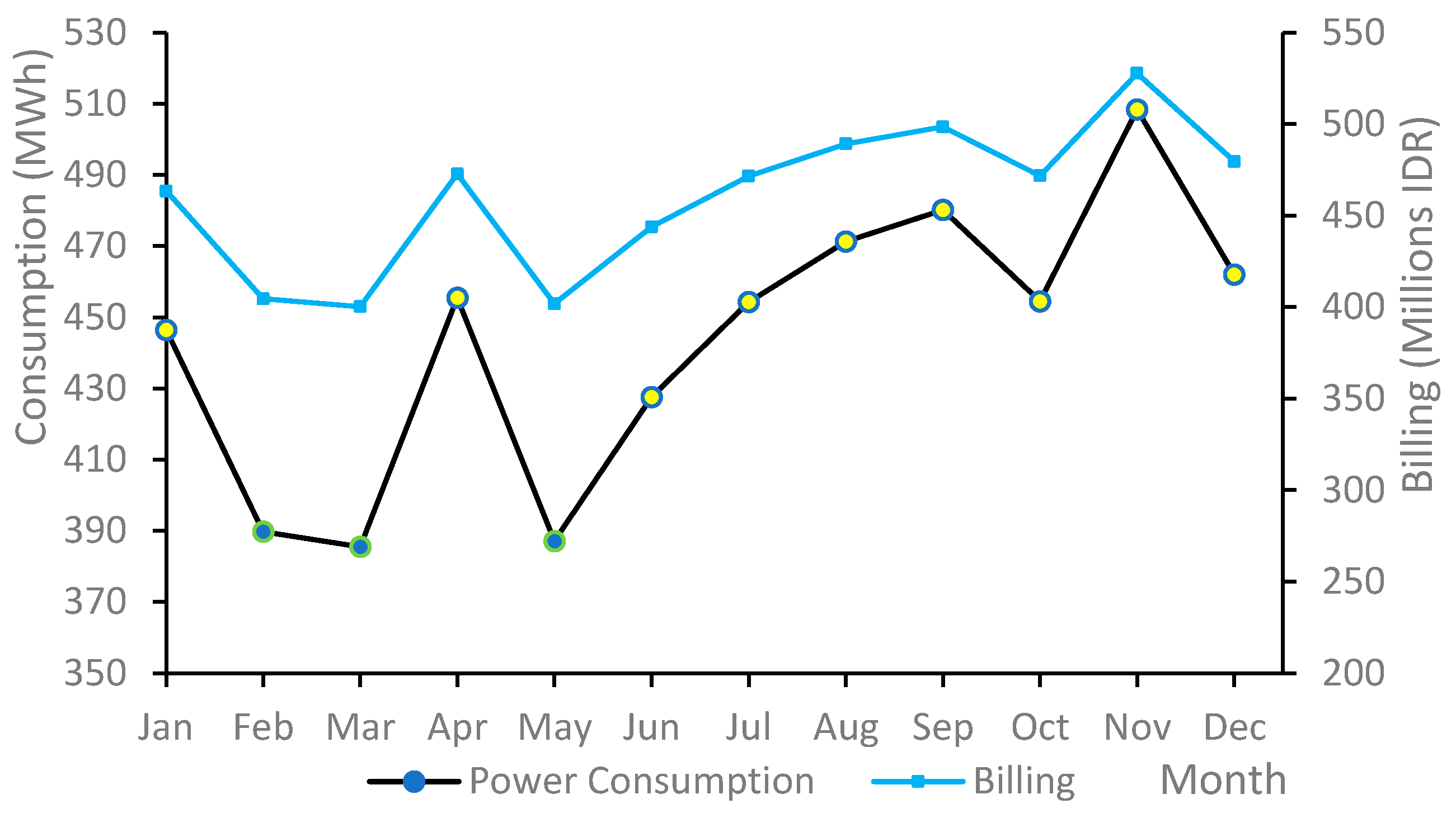
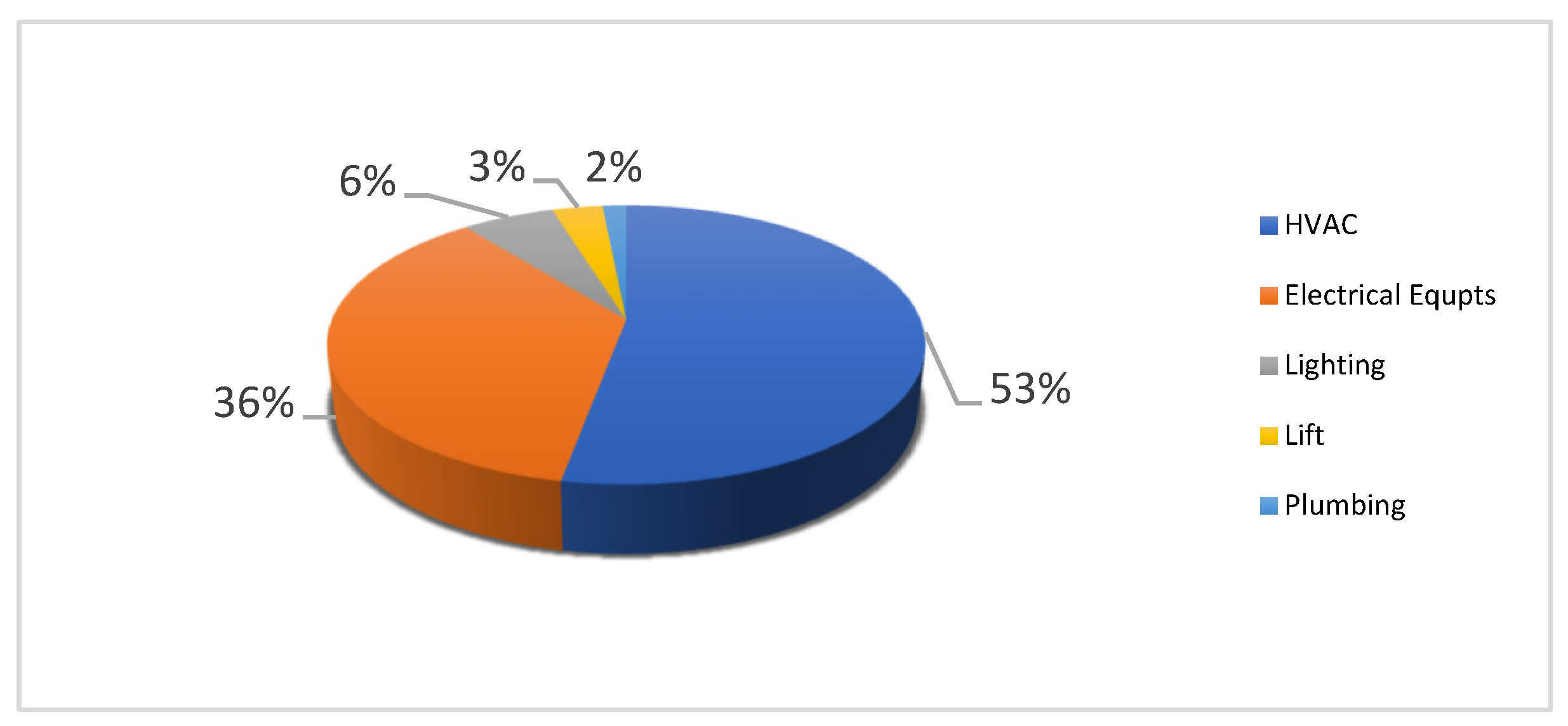
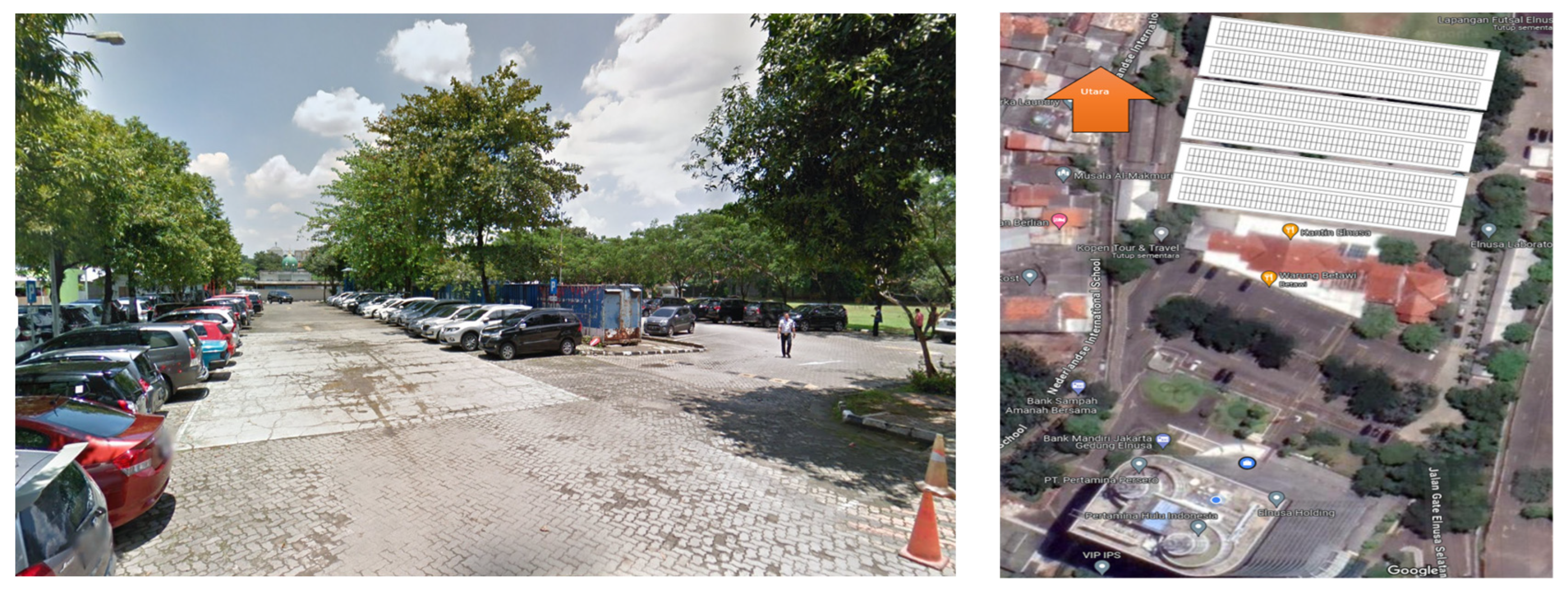
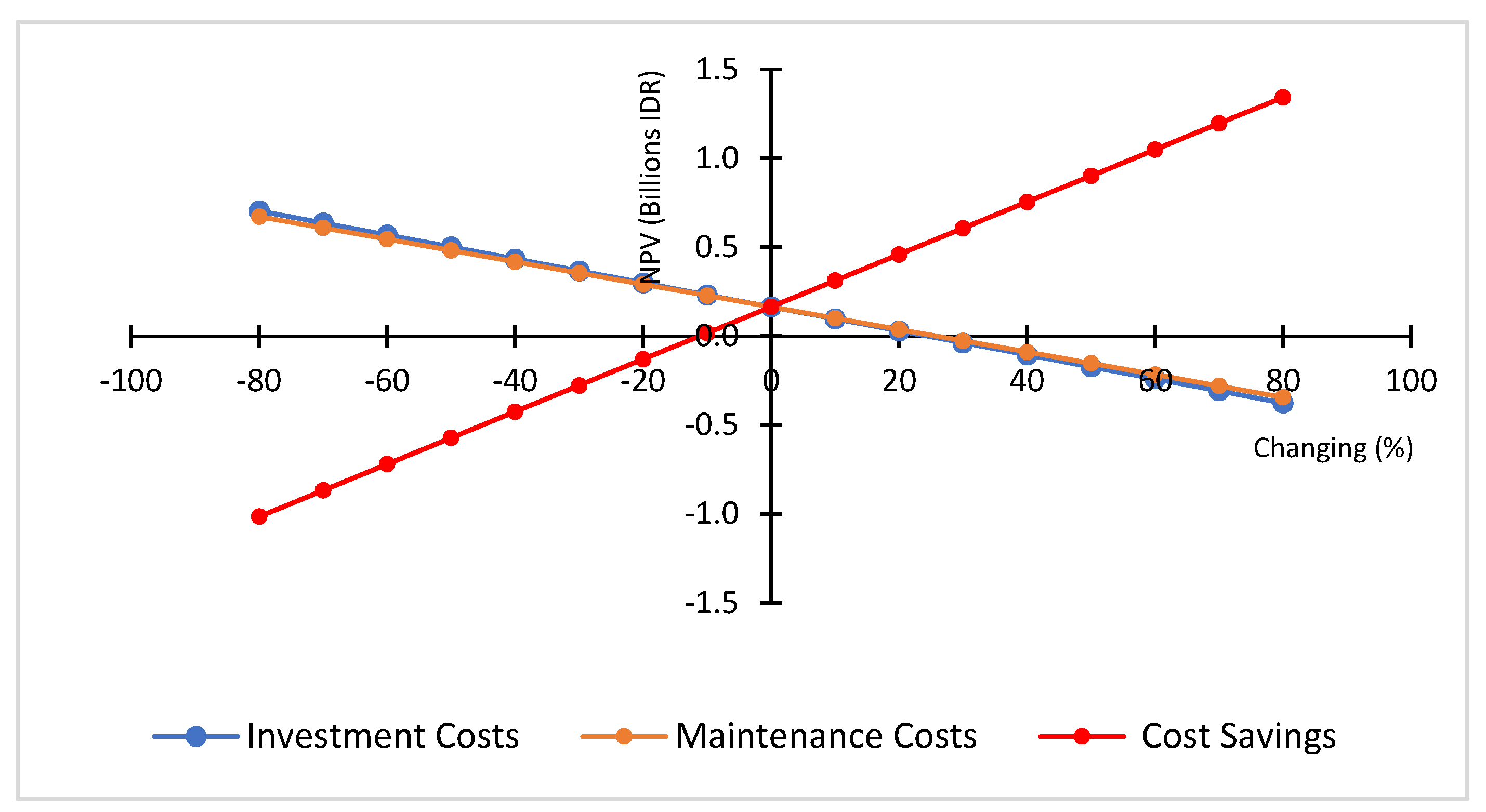
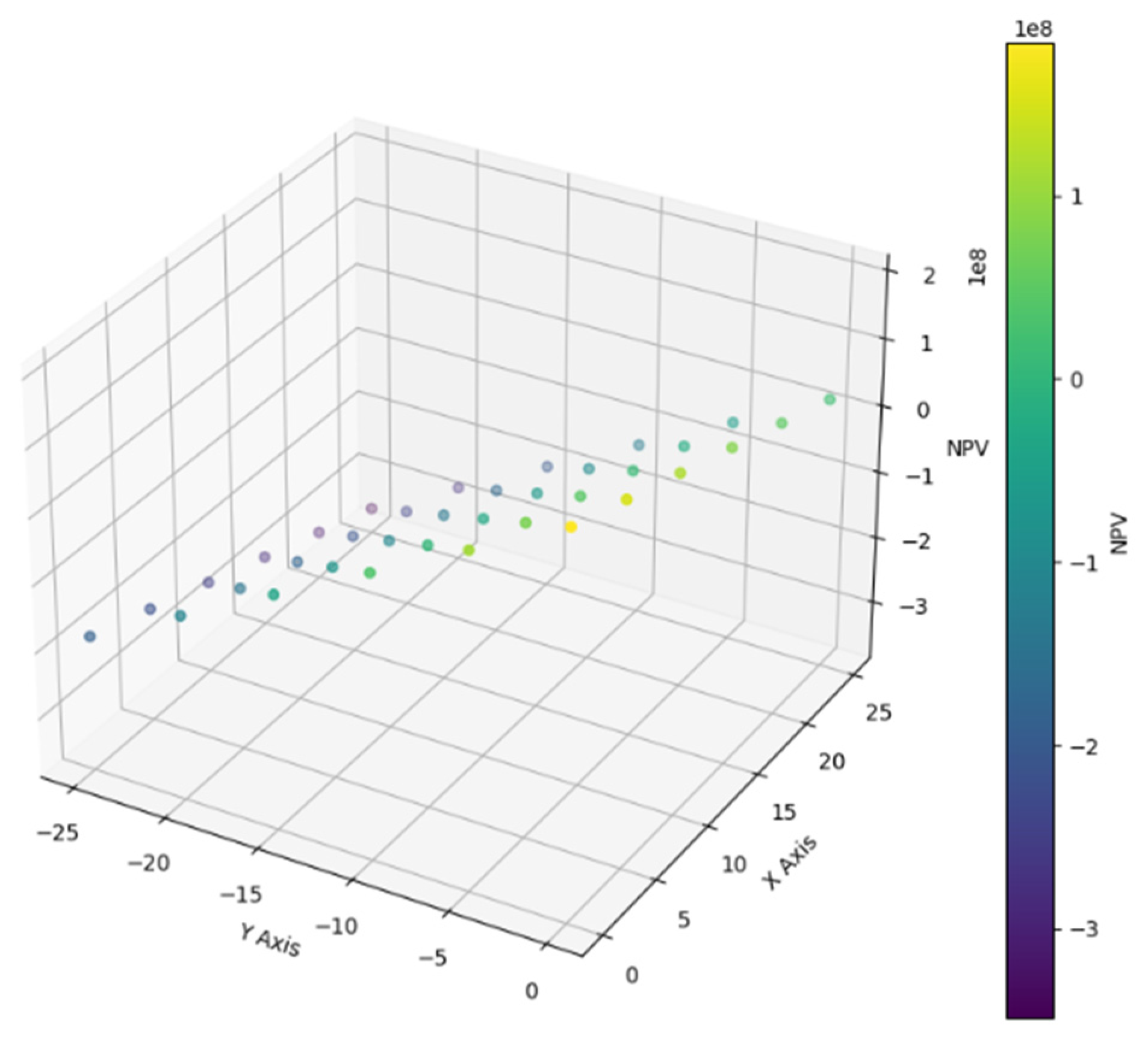
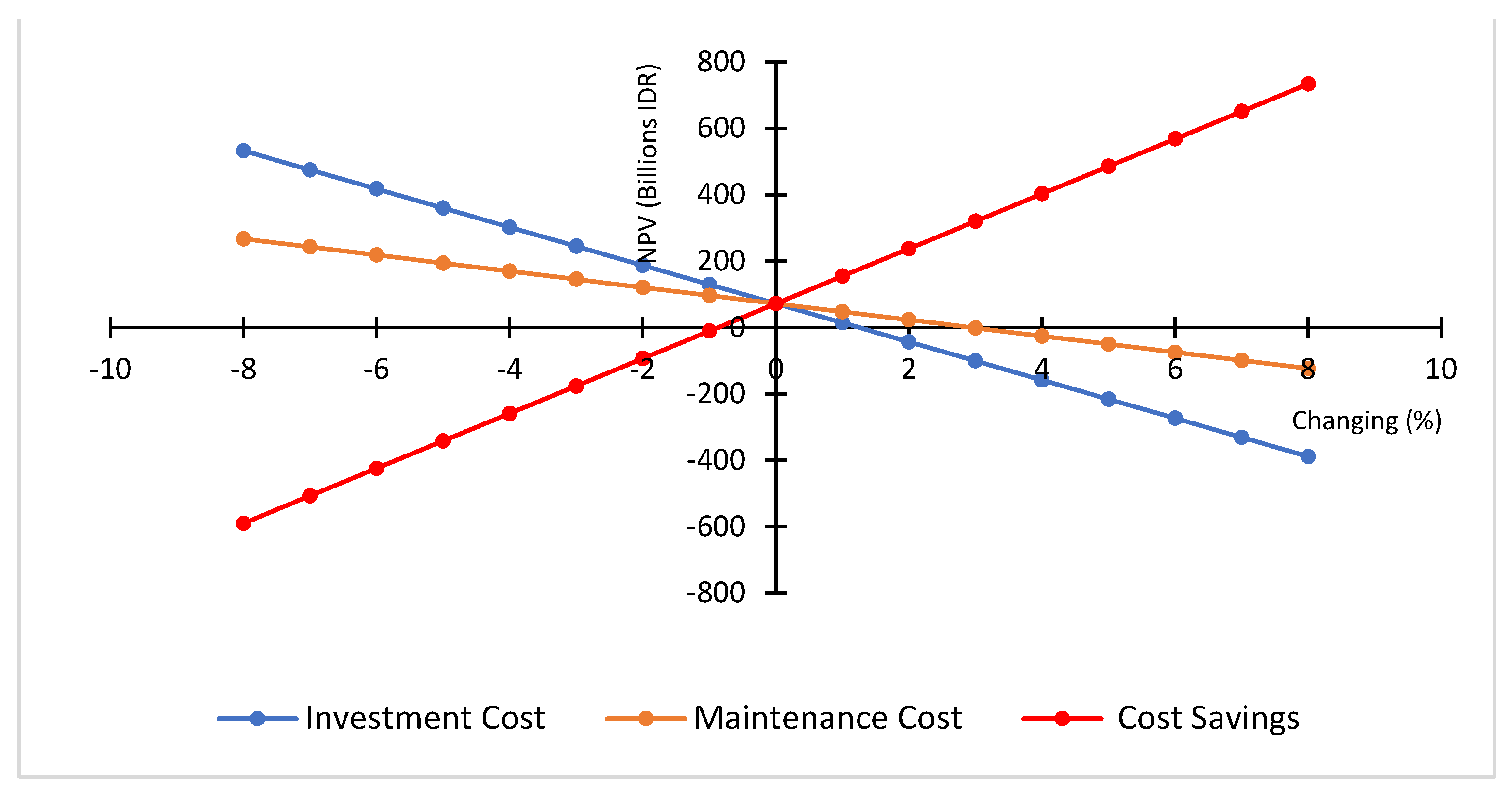
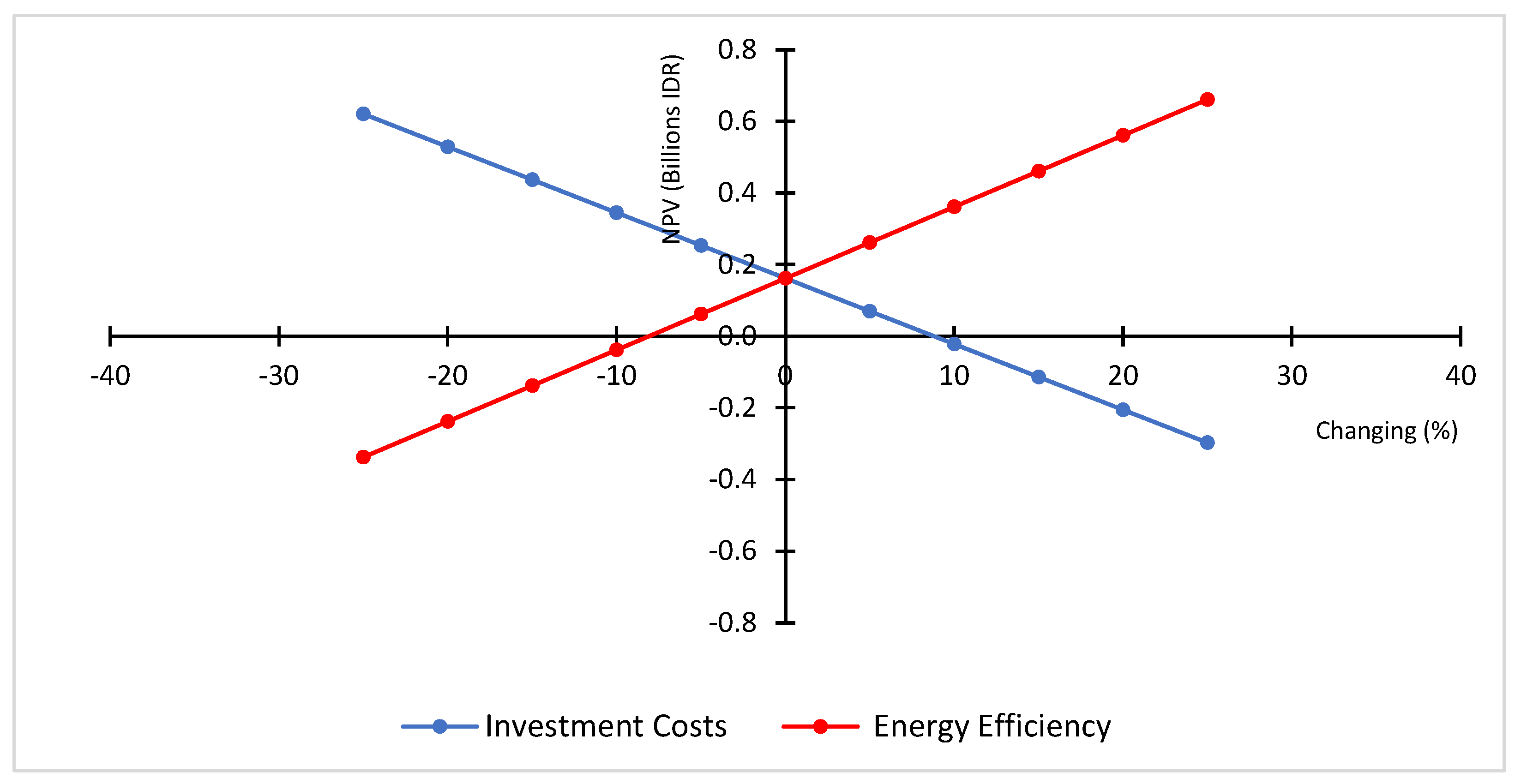
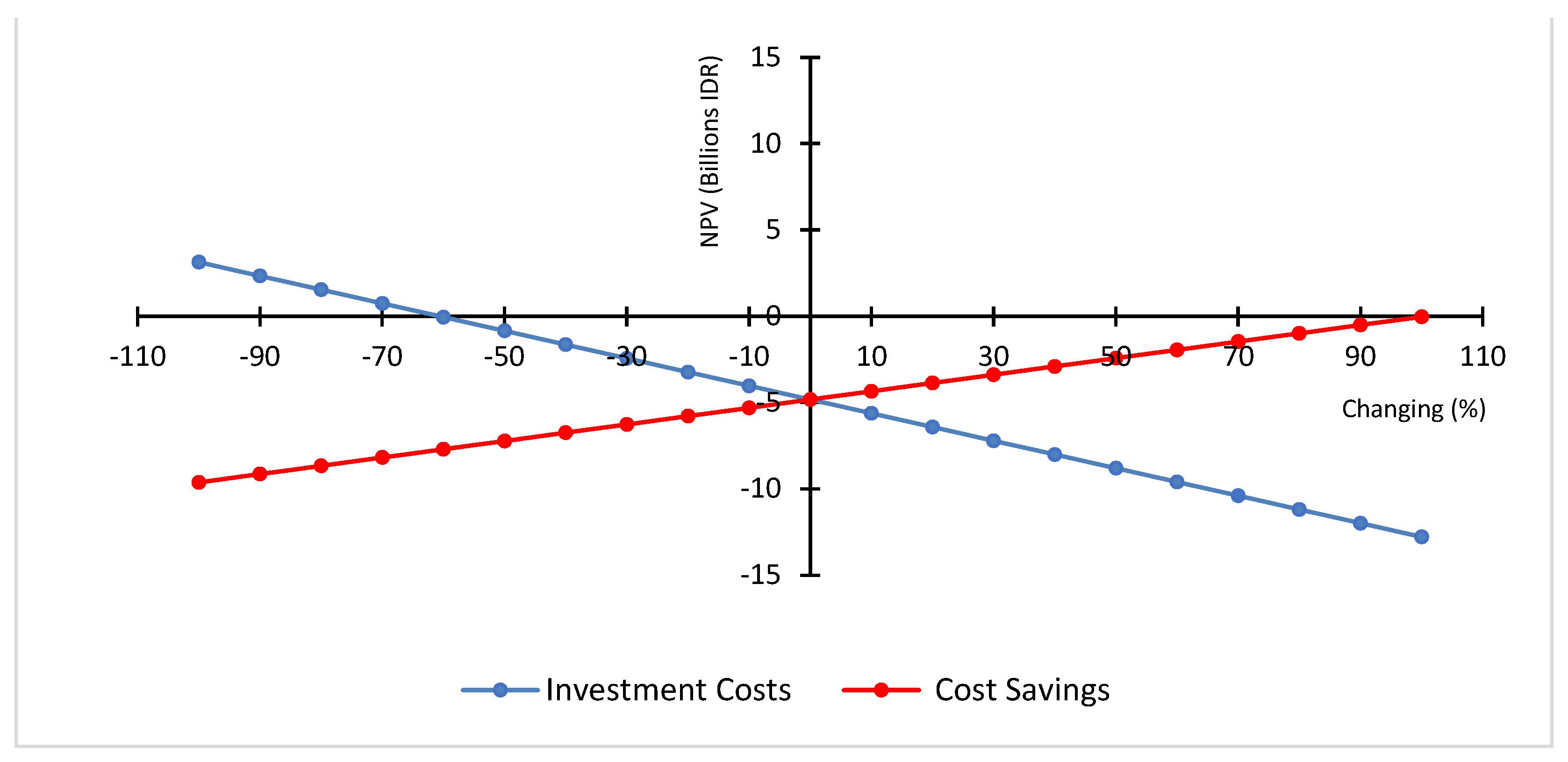
| Category | IKE Index (kWh/m2/Month) | |
|---|---|---|
| With AC | Without AC | |
| Very efficient | 4.17–7.92 | 0.84–1.67 |
| Efficient | 7.92–12.08 | 1.67–2.5 |
| Quite efficient | 12.08–14.58 | - |
| A bit wasteful | 14.58–19.17 | - |
| Wasteful | 19.17–23.75 | 2.5–3.34 |
| Very wasteful | 23.75–37.75 | 3.34–4.17 |
| No. | Criteria (Unit) | Quantity |
|---|---|---|
| 1 | Building age (year) | 26 |
| 2 | Building area (m2) | 27,338 |
| 3 | Building height (m) | 62.9 |
| 4 | Number of floors | 18 |
| 5 | Power capacity (kVA) | 2500 |
| 6 | Electricity tariff (IDR/kWh) | 1035.78 |
| No. | Item | Volume | Power (kW) | Energy Consumption (kWh/Year) | Cost (IDR/Year) |
|---|---|---|---|---|---|
| 1 | Cooling tower | 2 | 55 | 457,600 | 473,972,928 |
| 2 | CWP pump | 3 | 37 | 461,760 | 478,281,773 |
| Total | 919,360 | 952,254,701 | |||
| No. | Item | Volume | Power (kW) | Energy Consumption (kWh/Year) | Cost (IDR/Year) |
|---|---|---|---|---|---|
| 1 | Cooling tower | 2 | 45 | 374,400 | 387,796,032 |
| 2 | CWP pump | 2 | 48 | 399,360 | 413,649,101 |
| Total | 773,760 | 801,445,133 | |||
| No. | Item | Unit Price (Millions IDR) | Volume | Total (Millions IDR) |
|---|---|---|---|---|
| 1 | Brand new cooling tower | 165 | 2 | 330 |
| 3 | Brand new motor CWP | 56 | 2 | 112 |
| 4 | Project manager | 27 | 1 | 27 |
| 5 | Supervisor | 18.2 | 1 | 18.2 |
| 7 | Labor | 12.3 | 6 | 73.8 |
| 8 | Installation cost | 35 | 1 | 35 |
| 9 | Work safety equipment | 18.4 | 1 | 18.4 |
| 10 | Clearing | 18 | 1 | 18 |
| 11 | Trash disposal | 6.75 | 1 | 6.75 |
| Grand total | 639.15 | |||
| No. | Component (Unit) | Value |
|---|---|---|
| 1 | Investment cost (IDR) | 639,150,000 |
| 2 | Maintenance cost (IDR/year) | 44,200,000 |
| 3 | Cost saving (IDR/year) | 150,809,568 |
| 4 | Project duration (year) | 20 |
| 5 | Discount rate (%/year) | 8 |
| 6 | Performance deterioration (%/year) * | 1 |
| 7 | Maintenance costs increment rate (%/year) | 5 |
| No. | Equipment | Volume | Power (kW) | Energy Consumption (kWh/Year) | Cost (IDR/Year) |
|---|---|---|---|---|---|
| 1 | Cooling tower | 2 | 55 | 457,600 | 473,972,928 |
| 2 | WCPU | 34 | 20 | 2,828,800 | 2,930,014,464 |
| 3 | CWP | 3 | 37 | 461,760 | 478,281,773 |
| Total | 3,748,160 | 3,882,269,165 | |||
| No. | Equipment | Volume | Power (kW) | Daily Utilization (%) | Energy Consumption (kWh/Year) | Cost (IDR/Year) | ||
|---|---|---|---|---|---|---|---|---|
| 05:00–07:00 | 07:00–16:00 | 16:00–21:00 | ||||||
| 1 | Cooling tower | 2 | 55 | 30 | 90 | 50 | 320,320 | 331,781,050 |
| 2 | Water cooled package unit | 34 | 20 | 30 | 90 | 50 | 1,980,160 | 2,051,010,125 |
| 3 | CWP pump | 3 | 37 | 30 | 90 | 50 | 323,232 | 334,797,241 |
| Total | 2,623,712 | 2,717,588,415 | ||||||
| No | Item (Unit) | Unit Price (IDR) | Volume | Total Price (IDR) |
|---|---|---|---|---|
| 1 | BAS server (Ls) | 309,480,000 | 1 | 309,480,000 |
| 2 | Client PC (Ls) | 27,400,000 | 1 | 27,400,000 |
| 3 | Direct digital control (unit) | 15,262,504 | 34 | 518,925,136 |
| 4 | Modul DI (unit) | 6,980,000 | 218 | 1,521,640,000 |
| 5 | Modul DO (unit) | 5,384,615 | 150 | 807,692,250 |
| 6 | Modul AI (unit) | 5,230,461 | 145 | 758,416,845 |
| 7 | Modul AO (unit) | 4,715,384 | 111 | 523,407,624 |
| 8 | Air flow sensor (unit) | 1,384,615 | 34 | 47,076,910 |
| 9 | Water pressure sensor (unit) | 5,721,846 | 34 | 194,542,764 |
| 10 | Water level switch (unit) | 7,500,000 | 34 | 255,000,000 |
| 11 | Duct temperature (unit) | 3,250,000 | 17 | 55,250,000 |
| 12 | Room temperature sensor (unit) | 2,288,715 | 17 | 38,908,155 |
| 13 | Cable ITC 2 × 2 × 0.6 (m) | 32,000 | 5000 | 160,000,000 |
| 14 | Cable 18 AWG 1 pair (m) | 21,000 | 3500 | 73,500,000 |
| 15 | Cable Utp cat 6 (m) | 16,000 | 1500 | 24,000,000 |
| 16 | BAS software license (Ls) | 130,000,000 | 1 | 130,000,000 |
| 17 | Control panel (Ls) | 75,000,000 | 1 | 75,000,000 |
| Grand Total | 5,520,239,684 | |||
| No. | Component (Unit) | Value |
|---|---|---|
| 1 | Investment cost (IDR) | 5,520,239,684 |
| 2 | Maintenance cost (IDR/year) | 170,000,000 |
| 3 | Cost saving (IDR/year) | 1,164,680,749 |
| 4 | Project age (year) | 20 |
| 5 | Discount rate (%/year) | 8 |
| 6 | Performance deterioration (%/year) * | 5 |
| 7 | Increased maintenance cost (%/year) | 5 |
| No. | Operational Hours | Power (kW) | Volume | Usage (Hour) | Energy Consumption (kWh/Year) | Cost (IDR/Year) |
|---|---|---|---|---|---|---|
| 1 | 00:00–24:00 | 0.02 | 1298 | 24 | 161,990 | 167,786,417 |
| 2 | 04:00–21:00 | 0.02 | 3183 | 17 | 281,377 | 291,444,876 |
| Grand Total | 443,368 | 459,231,293 | ||||
| No. | Operational Hour | Power (kW) | Volume | Usage (Hour) | Energy Consumption (kWh/Year) | Cost (IDR/Year) |
|---|---|---|---|---|---|---|
| 1 | 05:00–07:00 | 0.02 | 1298 | 2 | 6750 | 6,991,101 |
| 2 | 07:00–16:00 | 0.02 | 4881 | 8 | 182,745 | 189,283,243 |
| 3 | 16:00–20:00 | 0.02 | 4881 | 4 | 50,762 | 52,578,679 |
| 4 | 20:00–05:00 | 0.02 | 1298 | 10 | 6750 | 6,991,101 |
| Grand Total | 247,006 | 255,844,123 | ||||
| No. | Item | Unit Price (IDR) | Volume | Total Cost (IDR) |
|---|---|---|---|---|
| 1 | Light sensor | 150,000 | 170 | 25,500,000 |
| 2 | Keypad sensor scheme | 250,000 | 170 | 4,250,000 |
| 3 | Power light sensor installation | 1,800,000 | 170 | 306,000,000 |
| 4 | Control light sensor installation | 50,000 | 4881 | 244,050,000 |
| 5 | LED dimmable 20 Watt | 180,000 | 4881 | 878,580,000 |
| Grand Total | 1,458,380,000 | |||
| No. | Investment Component (Unit) | Value |
|---|---|---|
| 1 | Investment cost (IDR) | 1,458,380,000 |
| 2 | 10th Year investment cost (IDR) | 878,580,000 |
| 3 | Cost saving (IDR/year) | 203,387,169 |
| 4 | LED dim light life (year) | 10 |
| 5 | Sensor age (year) | 20 |
| 6 | Discount rate (%/year) | 8 |
| No. | Provisions | Regulation of the Minister of Energy and Mineral Resources Regarding Rooftop Solar Power Plant | Object Condition | |
|---|---|---|---|---|
| No. 49 of 2018 [44] | No. 26 of 2021 [45] | |||
| 1 | The provisions to export the generated electricity to the greet (kilowatt-hours) | 0.65 | 1 | The Building’s annual energy demand is approximately 500 MWh, while the estimated output generated by solar panels is 50 MWh. Therefore, there is no surplus electricity available to export |
| 2 | Availability of export-import kWh meter | No later than 15 days after receiving SLO from PLN | Adjusted | |
| 3 | Accumulated surplus/deficit bill difference eliminated | Up to 3 months | Up to 6 months | No surplus output |
| 4 | Timeframe for rooftop solar power plant application | No later than 15 days | 5 days without adjustment of the Power Purchase Agreement (PPA) and 12 days with the PPA agreement | Adjusted |
| 5 | Consumer provisions | For PLN customers only | For both PLN customers and customers in non-PLN Business Areas (IUPTLU). | Entitled because they are PLN B3 customers |
| No. | Part (Unit) | Unit Price (IDR) | Volume | Total Price (IDR) |
|---|---|---|---|---|
| 1 | PV cable—inverter 6 mm (meter) | 22,000 | 6000 | 132,000,000 |
| 2 | Inverter cable—AC combiner (set) | 320,000 | 10,000 | 3,200,000,000 |
| 3 | AC combiner cable—LVCB tie in (meter) | 87,000 | 6000 | 522,000,000 |
| 4 | Ground system 1 (bundle) | 10,000,000 | 15 | 150,000,000 |
| 5 | Monitoring system cable (meter) | 5500 | 1000 | 5,500,000 |
| 6 | Cable accessories (pcs) | 12,500 | 100 | 1,250,000 |
| 7 | DC tray cable & accessories (pcs) | 650,000 | 300 | 195,000,000 |
| 8 | AC tray cable & accessories (pcs) | 1,250,000 | 300 | 375,000,000 |
| 9 | Controller (unit) | 20,000,000 | 3 | 60,000,000 |
| 10 | Installation & testing costs 1st (kWp) | 100,000 | 383.76 | 38,376,000 |
| 11 | SLO cost (lot) | 20,500,000 | 1 | 20,500,000 |
| 12 | Installation kit (kWp) | 100,000 | 383.76 | 38,376,000 |
| 13 | Installation & testing costs 2nd (kWp) | 900,000 | 383.76 | 345,384,000 |
| 14 | Monocrystalline solar panel 410 kWp (unit) | 1,800,000 | 936 | 1,684,800,000 |
| 16 | Lightweight steel canopy construction cost (m2) | 300,000 | 2310 | 693,000,000 |
| 17 | Grounding system 2 (bundle) | 10,000,000 | 12 | 120,000,000 |
| 18 | String inverter (unit) | 15,000,000 | 19 | 285,000,000 |
| 19 | AC combiner panel 150 kW (set) | 7,000,000 | 3 | 21,000,000 |
| 20 | AC combiner panel 75 kW (set) | 5,000,000 | 1 | 5,000,000 |
| 21 | Tie-in panel 150 kW (unit) | 15,000,000 | 3 | 45,000,000 |
| 22 | Tie-in panel 75 kW (unit) | 21,000,000 | 1 | 21,000,000 |
| Grand Total | 7,958,186,000 | |||
| No. | Item (Unit) | Unit Price (IDR/Year) | Volume | Total Price (IDR/Year) |
|---|---|---|---|---|
| 1 | Manpower (person) | 9,000,000 | 12 | 108,000,000 |
| 2 | Spare part & maintenance (package) | 7,958,186 | 1 | 7,958,186 |
| Grand Total | 115,958,186 | |||
| No. | Investment Component (Unit) | Value |
|---|---|---|
| 1 | Investment cost (IDR) | 7,958,186,000 |
| 2 | Project age (year) | 20 |
| 3 | Maintenance cost (IDR/year) | 115,958,186 |
| 4 | Cost savings (IDR/year) | 523,753,928 |
| 5 | Discount rate (%/year) | 8 |
| 6 | Performance deterioration (%/year) * | 1 |
| 7 | Maintenance cost increment rate (%/year) | 5 |
| No. | Project Combination | IKE | Category | Emission Reduction (ton CO2) | Investment Cost (IDR) | NPV (IDR) | Project Status |
|---|---|---|---|---|---|---|---|
| 1 | A | 15.78 | A bit wasteful | 116.0 | 655,347,754 | 183,580,999 | Feasible |
| 2 | B | 12.80 | Quite efficient | 899.56 | 5,520,239,684 | 72,165,340 | Feasible |
| 3 | C | 15.62 | A bit wasteful | 157.09 | 1,458,380,000 | 161,697,308 | Feasible |
| 4 | D | 14.68 | A bit wasteful | 404.53 | 7,958,186,000 | 4,824,831,009 | Infeasible |
| 5 | A + B | 12.36 | Quite efficient | 1015.56 | 6,175,587,438 | 176,312,254 | Feasible |
| 6 | A + C | 15.18 | A bit wasteful | 273.09 | 2,133,030,000 | 353,186,547 | Feasible |
| 7 | A + D | 14.24 | Quite efficient | 520.53 | 8,613,533,754 | 5,812,462,263 | Infeasible |
| 8 | B + C | 12.20 | Quite efficient | 1056.65 | 6,978,619,684 | 346,208,844 | Feasible |
| 9 | B + D | 11.26 | Efficient | 1304.09 | 13,478,425,684 | 4,442,725,422 | Infeasible |
| 10 | C + D | 14.09 | A bit wasteful | 561.62 | 9,416,566,000 | 4,563,289,440 | Infeasible |
| 11 | A + B + C | 11.76 | Efficient | 1172.65 | 7,633,967,438 | 437,853,822 | Feasible |
| 12 | A + B + D | 10.81 | Efficient | 1420.09 | 14,133,773,438 | 4,648,518,755 | Infeasible |
| 13 | B + C + D | 10.66 | Efficient | 1461.18 | 14,936,805,684 | 4,478,622,165 | Infeasible |
| 14 | A + B + C + D | 10.22 | Efficient | 1577.18 | 15,592,153,438 | 4,386,977,187 | Infeasible |
Disclaimer/Publisher’s Note: The statements, opinions and data contained in all publications are solely those of the individual author(s) and contributor(s) and not of MDPI and/or the editor(s). MDPI and/or the editor(s) disclaim responsibility for any injury to people or property resulting from any ideas, methods, instructions or products referred to in the content. |
© 2024 by the authors. Licensee MDPI, Basel, Switzerland. This article is an open access article distributed under the terms and conditions of the Creative Commons Attribution (CC BY) license (https://creativecommons.org/licenses/by/4.0/).
Share and Cite
Farizal, F.; Noviandri, M.A.; Hamdani, H. Sustainability Development through a Nearly Zero Energy Building Implementation Case: An Office Building in South Jakarta. Sustainability 2024, 16, 7027. https://doi.org/10.3390/su16167027
Farizal F, Noviandri MA, Hamdani H. Sustainability Development through a Nearly Zero Energy Building Implementation Case: An Office Building in South Jakarta. Sustainability. 2024; 16(16):7027. https://doi.org/10.3390/su16167027
Chicago/Turabian StyleFarizal, Farizal, Muhammad Aqil Noviandri, and Hanif Hamdani. 2024. "Sustainability Development through a Nearly Zero Energy Building Implementation Case: An Office Building in South Jakarta" Sustainability 16, no. 16: 7027. https://doi.org/10.3390/su16167027
APA StyleFarizal, F., Noviandri, M. A., & Hamdani, H. (2024). Sustainability Development through a Nearly Zero Energy Building Implementation Case: An Office Building in South Jakarta. Sustainability, 16(16), 7027. https://doi.org/10.3390/su16167027






